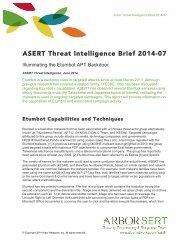Resources
1Va83Wx
1Va83Wx
- No tags were found...
Create successful ePaper yourself
Turn your PDF publications into a flip-book with our unique Google optimized e-Paper software.
Page 10<br />
www.osr.com<br />
A<br />
new version of Visual Studio brings along with it a new version of the Windows Driver Kit (WDK). And so it is for Windows 10.<br />
As Visual Studio (VS) and Windows itself continue to evolve, so does the WDK. With at least one notable exception (that we<br />
dearly hope is fixed soon) the new versions of VS and the WDK are changes for the better.<br />
Probably the biggest change is that WDK is now fully integrated. You can use it to build drivers for any desktop/server OS from<br />
Windows 7 onward. The WDK also includes built-in support for targeting 32-bit and 64-bit ARM processors, as well as Windows<br />
Mobile platforms. So, there's a lot more in the kit than was there by default previously.<br />
The Most Important Change<br />
Let's get one absolutely critical point out of the way immediately: They changed the menu bar titles back to upper and lower case<br />
by default. As far as I'm concerned, VS 2015 has me right there. But, in case you find yourself pining away for those menu items<br />
THAT SHOUT AT YOU, you can change back to all uppercase easily. Just go to Tools… Options… Environment… General… and<br />
UNcheck "Apply title case styling to menu bar" and you'll be good to go.<br />
OK? You happy? Now we can go on and deal with one or two other details.<br />
Coexistence<br />
You'll be happy to know that VS 2015 and the Windows 10 WDK and VS 2013 and the Windows 8.1 Update WDK can live happily<br />
side by side on your dev system. After installing the new versions of VS and the WDK, here at OSR we were able to build drivers<br />
successfully using either tool set. In fact, if we were careful and got our settings right, we were even able to switch back and forth<br />
between tool sets for projects that were initially created in VS 2013. In other words, we were able to open a (KMDF) driver project<br />
created in VS 2013 with the Win 8.1 Update WDK in VS 2015 with the Windows 10 WDK and build the Solution without any<br />
problems. Our Configurations (Win 7 Debug, for example) showed up and could be selected just as you would in VS 2013. Even<br />
more interesting, after doing this we were able to open that same solution in VS 2013 and build it successfully using the Windows<br />
8.1 Update WDK.<br />
The key to making this work is paying attention to the "Platform Toolset" setting in the Configuration Properties (General section)<br />
of each project (shown in Figure 1).<br />
When you first open a Windows 8.1 WDK<br />
project with VS 2015, it asks you if you<br />
want to convert the projects to the new<br />
toolset. If you agree, the Platform Toolset<br />
will be changed to appropriate Win10<br />
versions. In this case, when you build your<br />
driver you'll be using the new project<br />
configurations, the new compiler and the<br />
new linker.<br />
If you do not let VS convert the projects to<br />
VS 2015, it will use the toolset that was<br />
previously defined for each project when<br />
you build your code. That means even if<br />
you choose to do your editing in VS 2015,<br />
you can choose which toolset VS will use<br />
for compiling and linking.<br />
Figure 1—Using VS 2015…but building drivers with the VS 2013 tools<br />
In summary, the power is in your hands to<br />
choose the tools you want to use to build<br />
your driver. And the IDE that you use for<br />
editing does not necessarily dictate which<br />
tools you'll use. Cool, right?<br />
(CONTINUED ON PAGE 11)<br />
The NT Insider July - August 2015 © OSR Open Systems <strong>Resources</strong>, Inc.







